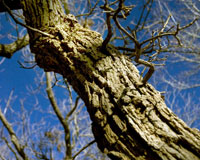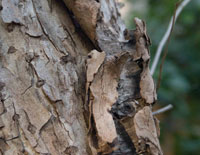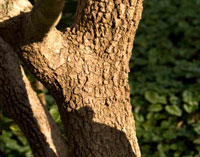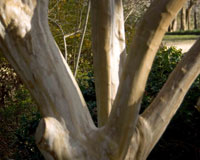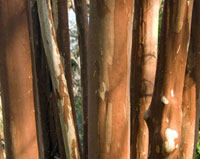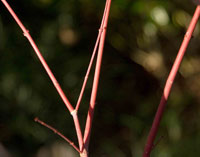From the Sperry Gardens – December, 2010
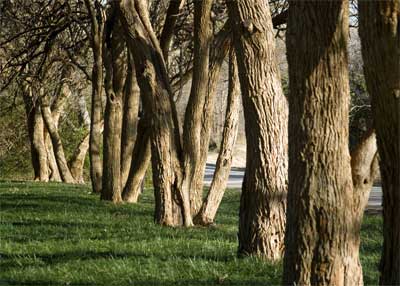
Old fencerow of bois d’arc trunks in winter.
Your friends may look at you with concern if you start hawking the virtues of your trees’ lovely barks, but at least you and I will know that you’re right. Tree bark can provide a lot of wintertime sparkle if you just choose and place your plants carefully.
Perhaps my best example of tree bark en masse is from this old fencerow of bois d’arcs along our county road. They’ve been through a lot, and I love the look they show in the winter sunlight.
Here are a few more of my favorites from my own landscape.
Bur oak: I like coarse-textured tree bark. Cottonwoods, river willows and eastern persimmons all have dramatically coarse bark, but so does this gnarled bur oak growing behind our home. What wonderful character it brings to its part of the garden.
Mexican plum: Native to much of Central Texas, this wild plum is deliciously fragrant in the spring, and the small fruit that mature in the fall are favorites with wildlife. The winter show comes from its incredibly scaly bark. Nice plant at all seasons, but I have a special fondness for it during the cold months.
Rusty blackhaw viburnum: This is a 12-month-a-year plant in our landscape. I guess it qualifies as a coarse bark, but I wanted to give it its own special shout-out. We had a native rusty blackhaw when we built our home. I added a second one 20 years ago. Rusty blackhaw is a large shrub or small tree that grows to 15-20 feet tall and 12-15 feet wide. Once the plant gains some size and age, its bark is the star in the winter. Spring’s new growth is bright, glossy green, and it’s punctuated by clusters of lovely white blooms. Summer’s color is deep glossy green, and the fall color is reddish and orange. Finally, in late fall and into the winter you’ll find b-b-sized purple fruit. That is, if the birds don’t find them first.
Crape myrtle: At the opposite extreme, some of the slickest, smoothest bark available anywhere comes on our venerable old crape myrtles. Each spring, big sheets of the old bark fall to the ground, exposing colorful new tissues in the process. The old "indica" varieties (like my Glendora White) have honey-colored trunks as they age. The U.S.D.A.’s newer types (such as my Natchez) have darker, cinnamon-shaded bark. Whatever the bark colors, they’re all very nice.
Coral bark maple: This little sister to the popular Japanese maples has gained notoriety in its own right. Its winter bark (actually, twig) color is really quite showy. It’s interesting to watch it change from summer’s conventional greenish to this cheery shade of coral red as the weather cools. My only misgiving with this shade-loving (actually, shade-needing) tree is that the summer foliage color is light, yellowish green. I have mine growing in front of a yaupon holly tree, and the deep green of the holly can make the maple look a little bit sickly. I wish I’d arranged them just a little bit differently, but they’re both too large to move. I love them both anyway.
Yaupon holly: This is singly the best and most expensive plant I’ve ever bought. I got it 33 years ago, and it’s just gotten better over time. The trunks are now 4 to 5 inches in diameter, and when the winter sun hits them directly, it makes a stunning highlight in that side part of our garden. I bought this handsome specimen to get a mature privacy plant to screen our house from the county road. It did its job immediately. For the record, I bought a male yaupon. I wanted it to grow larger faster, and I knew the male wouldn’t spend resources producing berries.


